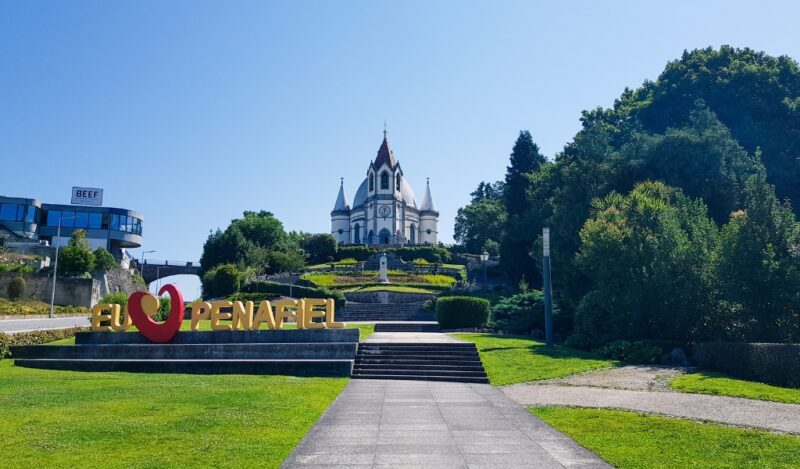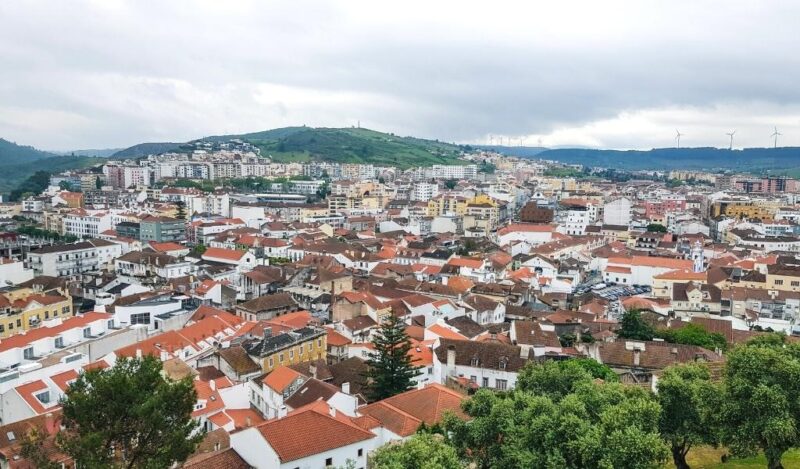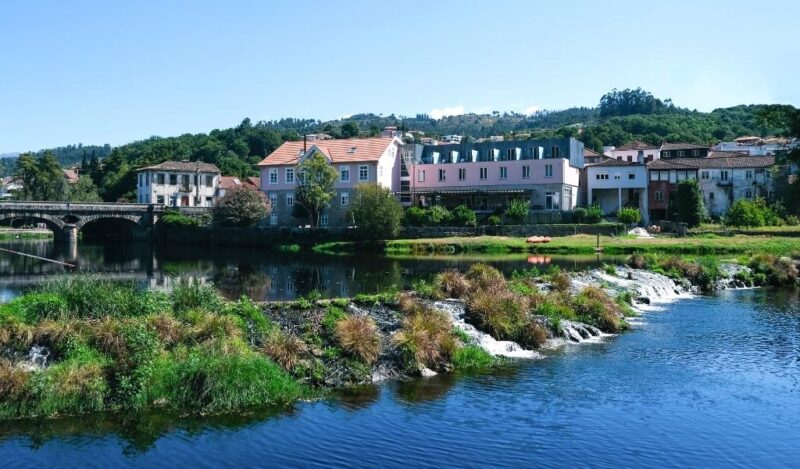Giverny is a lovely village mostly known as the location of Claude Monet‘s home and gardens, including his famous pond of water lilies. Wherever your look, you’ll notice a fairytale-like essence, which was so beautifully captured on a canvas by Monet and by some other Impressionist painters.
Located in the Normandy region, Giverny is definitely a must-visit destination from Paris, since it’s less than 60 minutes away from the French capital. You’ll love the bucolic landscapes, the massive flower fields (that bloom almost all year round), and basically the overall atmosphere.
So, do you want to know more about 1 Day In Giverny: The Perfect Giverny Itinerary? Keep reading!
This post may contain affiliate links, meaning I earn a small commission if you make a purchase, at no additional cost to you. Please read my disclosure & privacy policy for more information.
No time to read now? Pin it for later!


Brief History of Giverny
The commune of Giverny has such an intrinsic relationship with Claude Monet’s house and gardens that it’s easy to forget its own history before the French painter discovered it in 1893. First of all, the name derives from its Latin version Giverniacum, which was registered more than 1500 years ago!
Therefore, it’s thought that the village was founded at the time of the Merovingian dynasty, somewhere between 450 and 750 AC. Decades later, there are historical references that King Charles II of France “offered” Giverny to the monks at Abbaye Saint-Denis-le-Ferment, just over 35 km away.
In the 11th century, the Église Sainte-Radegonde began to be built at the behest of the monks of the Abbaye Saint-Ouen de Rouen – a construction that would take about 500 years to complete! Moreover, in the cemetery next to the church, you’ll find the tomb of Claude Monet and his family.

In 1883, Monet saw Giverny during a train ride and decided to move to the quiet village with Alice Hoschedé, her six children, and the two children from his first marriage to Camille Doncieux. The property consisted of a long pink country house with green windows and shutters (called Le Pressoir), as well as a plot of land of considerable length.
The artist, who loved gardening almost as much as painting, created numerous flower beds, vegetable gardens, and orchards in front of his residence, during the early years in Giverny. In 1893, Monet bought a plot near his home, which contained a lake that he called Le Jardin d’Eau. Nowadays, there’s not only a road that separates these two lands, but it’s also necessary to pass under it to access the Water Garden.
Visiting Giverny
Although I arrived in Giverny by car, you can visit the village by taking a train in Paris. To do this, you only have to go to the Gare Saint Lazare and choose as destination the Gare de Vernon (check the schedules here). This trip takes about 45-50 minutes and costs €32 (roundtrip).
Once in Vernon, there’s a shuttle that takes you to Giverny, leaving the station 15 minutes after the arrival of each train (check timetables here). The ticket price is €10 (roundtrip) and it can be purchased near the driver or through the SNgo! app.
The Fondation Claude Monet-Giverny – that is, the house and gardens – is open every day, from 9:30 am to 6 pm, with the last entry taking place at 5:30 pm. The ticket costs €9.50 (adults) and €5.50 (children and students), but children under 7 years old don’t pay for admission.
The foundation itself advises buying the tickets online, in order to avoid long queues, especially during high season. There’s similarly an online shop, which sells the products of the physical gift and book shop – built on the old Atelier des Nymphéas.
Giverny Itinerary
Maison de Claude Monet
On the ground floor, the visit to Claude Monet‘s House begins in the so-called “Le Petit Salon Bleu”, a reading room where part of his extensive collection of Japanese prints is displayed. Soon after, comes the Épicerie, the pantry where eggs, spices, tea, and olive oil were kept in custom cabinets.
From here, the Salon-Atelier follows, which is certainly the most important space in the house. This was Monet‘s first studio, where he worked until 1899. Recreated in 2011 with the original layout of his time, it contains about sixty replicas of his paintings.
Going up to the first floor, which basically consists of family rooms, you can visit the Painter’s Room (la Chambre du Peintre). With a wonderful view over the gardens, this space was also restored in 2013.

Next is Monet’s bathroom and Alice’s bathroom and bedroom, the latter two with more Japanese prints hanging on the walls. There’s also a small sewing room and, at the end of the hall, Blanche’s room (the impressionist master’s stepdaughter and daughter-in-law), which only opened to the public in 2014.
The visit ends back on the ground floor, passing through the dining room, completely painted and furnished in yellow (and filled with more Japanese prints). This communicates with the kitchen, decorated with blue tiles from Rouen and which still retains an enormous set of copper pots and pans. To conclude, the country house has a porch across the front, so there are doors that give direct access to the street on almost all ground floors. Another peculiarity is that there are no windows at the rear of the house!
Jardins de Claude Monet
Claude Monet‘s gardens have dozens and dozens of flowers of all colors and shapes. Some of these species are dahlias, irises, nasturtiums, poppies, and oriental poppies.

Initially, the garden in front of the house (le Clos Normand) had many apple trees, but the painter replaced them with some apricot trees and sakuras, the blossoming cherry trees of Japan.
The Water Garden has strong oriental inspirations, as it is full of bamboo, peonies, wisterias (on the Japanese bridge), and weeping willows, as well as agapanthus and the famous water lilies that cover the lake and that Monet so often portrayed.
Ancien Hôtel Baudy
The Old Hotel Baudy is a restaurant located just 5 minutes from the Claude Monet Foundation. This place has an impressive past if it weren’t for the fact that it served as a place of conviviality (and accommodation) for the many artists who came to visit Monet in Giverny!
The Hôtel Baudy started out as a mix of “grocery store and snack bar”, until 1886 when the American painter Willard Leroy Metcalf came to ask the owners (Angélina and Lucien Baudy) for accommodation. Although he was refused a stay that first time, the artist returned with three more countrymen and Madame Baudy was unable to say no.
Upon discovering that Claude Monet lived next door (and getting to know himself), the Americans rushed to announce their discovery to every artist in Paris. Thus, Hôtel Baudy became one of the “trendy spots”, just outside the French capital.
This new “meeting place” welcomed names such as Pierre-Auguste Renoir, Auguste Rodin, Alfred Sisley, and Pablo Picasso, as well as many American painters, who nicknamed it the “Hotêl des Peintres Americains”. Among them are, for example, John Singer Sargent, William Hart, James Carroll Beckwith, Dawson Dawson-Watson, Frederick William MacMonnies, and Frederick Carl Frieseke.


Nowadays, the old hotel has become a charming and very welcoming restaurant, with period decor and serving typical specialties of the region (and the country). In addition, it conserves an artist’s Studio (Atelier) and an Arborized Park (Parc Arboré) from the time of Claude Monet, which are freely accessible to the restaurant’s customers.
The restaurant offers meals in an indoor room (Salle à Manger) and in a space suitable for events, ceremonies, or larger groups (Salle de Réception). However, if the weather is inviting, I would recommend having lunch/dinner outside in the Terrasse. It’s an extremely nice and lovely area, with constant shade and very well inserted in the countryside of Giverny.
I tried a hot vegetarian dish called “Camembert Chaud” because I love this cheese and it came with roasted potatoes, lettuce, and toasted rustic bread. Not only was it delicious, but the dish came very well garnished! If you want to plan your meal at the Ancien Hôtel Baudy, you can make your reservation on the restaurant’s official website (open Tuesday to Saturday, from 11 am to 11 pm and on Sundays, from 11 am to 6 pm).
Musée des Impressionnismes
The Museum of Impressionisms in Giverny was created in 2009, in the building where the Musée d’Art Américain once stood. As the name implies, the art museum is dedicated to the Impressionist movement, with a permanent exhibition on Claude Monet and his fellow painters and a few temporary exhibitions per year.
The Musée des Impressionnismes is 2 minutes away from the Claude Monet Foundation and the Ancien Hôtel Baudy. Regarding the opening hours, it is open every day from 10 am to 6 pm, but during the low season, it only works on Fridays and weekends (check the calendar here). You can also visit the museum on holidays, except on December 25th and January 1st. Finally, tickets cost €7.50 (adults), €5 (12-17 years old), and €3.50 (7-11 years old) (access the online ticket office here).
Map of the Giverny Itinerary
Share this blog post on your social media!
More Posts about Gardens and Parks
How To Visit The National Hunting Park Of Mafra In 2024
National Palace Of Queluz: Best Tips For Visiting In 2024
How To Visit The National Forest Of The Seven Hills In 2024
More Posts about Travel Itineraries
1 Day In Penafiel: The Perfect Penafiel Itinerary
1 Day In Torres Vedras: The Perfect Torres Vedras Itinerary
2 Days In Arcos De Valdevez: The Perfect Arcos De Valdevez Itinerary
What Photography Gear Do I Use?
- Camera Body: Fujifilm X-T4 Mirrorless
- Camera Lens: Fujinon XF 18-55 mm F2.8-4 R LM OIS
- Tripod: Manfrotto Compact Action
- Small Tripod: Manfrotto PIXI Mini
- Smartphone Adaptor: Manfrotto PIXI Clamp
- Memory Card: SanDisk 128GB Extreme PRO SDXC






